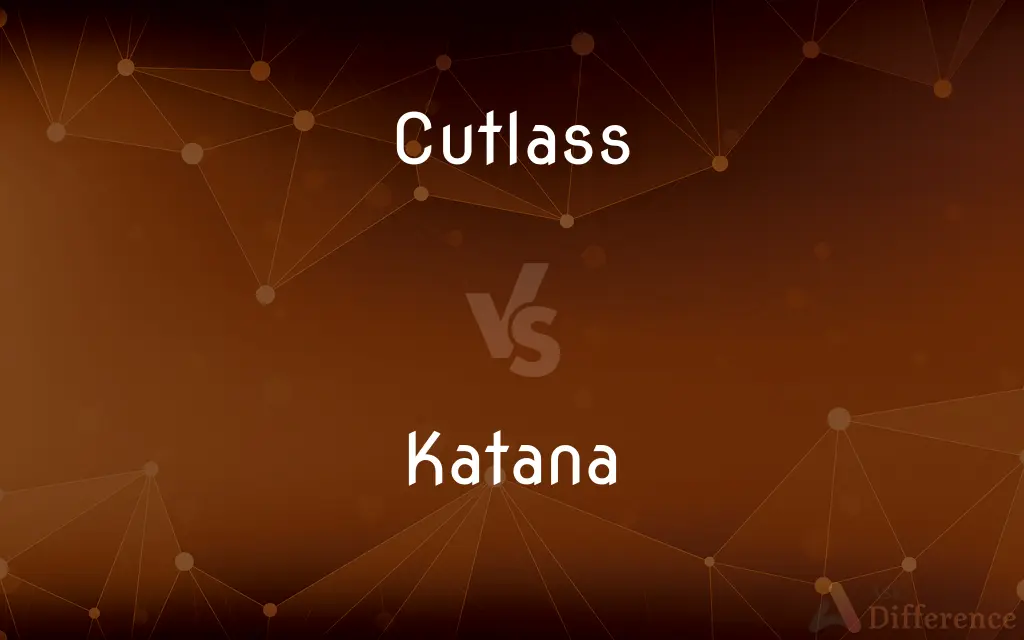Cutlass vs. Katana — What's the Difference?
By Maham Liaqat & Urooj Arif — Updated on April 14, 2024
A cutlass is a short, broad saber with a slight curve, used primarily for naval engagements, while a katana is a long, slender, and sharply curved Japanese sword, known for its use by samurai.

Difference Between Cutlass and Katana
Table of Contents
ADVERTISEMENT
Key Differences
The cutlass, characterized by its short, broad blade and slight curvature, was designed for close combat, especially useful in the cramped conditions of naval ships. In contrast, the katana features a more pronounced curve and a longer blade, optimized for cutting efficiency and quick draw techniques in open combat.
Historically, the cutlass was a standard tool and weapon among pirates and sailors from the 17th to the 19th centuries, serving both as a fighting blade and a utility tool. Meanwhile, the katana holds a prestigious place in Japanese culture, symbolizing the honor and duties of the samurai class during feudal Japan.
The cutlass is typically equipped with a solid, basket-style handguard to protect the wielder’s hand during shipboard melees. On the other hand, the katana boasts a tsuba (hand guard) that is often ornately designed but smaller, focusing on balance and aesthetic rather than full hand protection.
In terms of technique, the cutlass was used in chopping motions suitable for the restrictive space on ships, where swinging a longer sword would be impractical. The katana, however, relies on precise, fluid slashes and has a cutting technique that has been refined over centuries into various martial arts forms.
The metallurgy of the katana involves a sophisticated forging process that includes folding and differential hardening, creating a blade renowned for its sharpness and strength. Conversely, cutlasses were generally made from simpler, though robust, steel to withstand the tough conditions at sea and frequent use in combat and daily ship activities.
ADVERTISEMENT
Comparison Chart
Origin
Western (European, American)
Eastern (Japanese)
Blade Length
Shorter (about 60-75 cm)
Longer (about 60-80 cm)
Usage
Naval combat, close quarters
Battlefield and personal combat, dueling
Blade Shape
Broad and slightly curved
Long, slender, and sharply curved
Cultural Significance
Associated with pirates and naval warfare
Symbol of the samurai's honor and status
Compare with Definitions
Cutlass
Known for its sturdy build suitable for shipboard life.
Every sailor was equipped with a cutlass as a tool and weapon.
Katana
A traditional Japanese sword with a curved, slender blade.
The samurai unsheathed his katana, ready for battle.
Cutlass
A short, broad saber used historically by sailors.
The pirate swung his cutlass fiercely during the boarding attack.
Katana
Symbolizes the honor and values of the samurai.
His katana was a family heirloom, representing centuries of tradition.
Cutlass
Features a slight curve optimized for chopping.
The cutlass was ideal for close combat on the crowded decks.
Katana
Used in various forms of martial arts.
He practiced daily with his katana, honing his skills in Kenjutsu.
Cutlass
Used primarily during the Age of Sail.
The cutlass was a common sight on ships from the 17th to the 19th century.
Katana
Features a distinctively sharp edge and a pointed tip.
The katana's blade was so sharp it could cut silk in the air.
Cutlass
Often comes with a basket hilt for hand protection.
His cutlass's basket hilt saved his fingers during the skirmish.
Katana
Often has a decorative tsuba that balances the blade.
The katana's tsuba was intricately designed with family crests.
Cutlass
A cutlass is a short, broad sabre or slashing sword, with a straight or slightly curved blade sharpened on the cutting edge, and a hilt often featuring a solid cupped or basket-shaped guard. It was a common naval weapon during the early Age of Sail.
Katana
A katana (刀 or かたな) is a Japanese sword characterized by a curved, single-edged blade with a circular or squared guard and long grip to accommodate two hands. Developed later than the tachi, it was used by samurai in feudal Japan and worn with the blade facing upward.
Cutlass
A short heavy sword with a curved single-edged blade, once used as a weapon by sailors.
Katana
A long, single-edge sword for use with two hands, traditionally worn by samurai.
Cutlass
(Caribbean) A machete.
Katana
A type of Japanese longsword or tr=nihontō, having a single edge and slight curvature, historically used by samurai and ninja.
Cutlass
(nautical) A short sword with a curved blade, and a convex edge; once used by sailors when boarding an enemy ship.
Cutlass
A similarly shaped tool; a machete.
Cutlass
(transitive) To cut back (vegetation) with a cutlass.
Cutlass
A short, heavy, curving sword, used in the navy. See Curtal ax.
Cutlass
A short heavy curved sword with one edge; formerly used by sailors
Common Curiosities
What is the primary function of a cutlass?
The primary function of a cutlass is close-quarters combat, particularly on naval ships.
How does the katana's design reflect its use?
The katana's design, with its curved blade and sharp edge, reflects its use for swift, clean cuts in combat.
What does the katana symbolize in Japanese culture?
The katana symbolizes the honor, duty, and precision of the samurai class.
Can a cutlass be used as a tool?
Yes, the cutlass was also used as a utility tool on ships for cutting ropes and other materials.
What materials are typically used to make a cutlass?
Cutlasses are typically made from steel, designed to be durable and withstand the harsh marine environment.
What type of steel is used in making a katana?
Katanas are traditionally made from a type of steel known as tamahagane, which is known for its ability to hold a sharp edge.
Is there a ceremonial significance to the katana in Japanese culture?
Yes, the katana holds ceremonial significance in Japanese culture, often used in various rites and as a symbol of status and honor among the samurai.
Were cutlasses used by any specific countries or cultures?
Cutlasses were widely used by European and American naval forces and are closely associated with the golden age of piracy.
How is a katana traditionally forged?
A katana is traditionally forged through a process that involves folding the metal multiple times and differential hardening, creating layers that enhance its strength and cutting ability.
How did sailors traditionally carry their cutlasses?
Sailors traditionally carried their cutlasses in a sheath attached to their belts, allowing for easy access during battles or when performing duties on ship.
What is the difference in balance between a cutlass and a katana?
A cutlass is balanced for chopping with a robust handle to prevent slippage, whereas a katana is balanced more towards the hilt to facilitate quick, precise slicing movements in combat.
Are there modern uses for katanas and cutlasses today?
Today, katanas are primarily used in martial arts and ceremonial displays, while cutlasses are mostly ceremonial or collectible items, though they may also appear in historical reenactments.
Did the design of the cutlass evolve over time?
Yes, the design of the cutlass evolved over time, mainly to improve hand protection and enhance its utility as both a weapon and a tool on naval ships.
What is the significance of the curve in a katana's blade?
The curve in a katana's blade helps in delivering effective cutting strokes and allows for a quicker draw of the sword from the scabbard.
Share Your Discovery

Previous Comparison
Pedagogue vs. Pedantic
Next Comparison
Fulled vs. FilledAuthor Spotlight
Written by
Maham LiaqatCo-written by
Urooj ArifUrooj is a skilled content writer at Ask Difference, known for her exceptional ability to simplify complex topics into engaging and informative content. With a passion for research and a flair for clear, concise writing, she consistently delivers articles that resonate with our diverse audience.















































